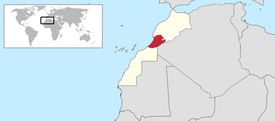Sus
| |
|---|---|
Region | |
| Coordinates: 30°05′N 8°29′W / 30.08°N 8.48°W | |
| Country | |
| Region | Souss-Massa, Guelmim-Oued Noun |
The Sous region (also spelt Sus, Suss, Souss or Sousse) (Arabic: سوس, romanized: sūs, Berber languages: ⵙⵓⵙ, romanized: sus) is a historical, cultural and geographical region of Morocco, which constitutes part of the region administration of Souss-Massa and Guelmim-Oued Noun. The region is known for the endemic argan tree (which has become a symbol of Souss) as well as for being the capital of the Shilha Berber ethnic group. It is a major commercial and tourist agricultural region of the Kingdom. Vegetable production, shared between very large farms and small producers, contributes to the economic development of the region. The Souss plain produces 40% of Moroccan citrus fruits, and 60% of the production of early vegetables.[1] It is historically a stage of trans-Saharan trade.
YouTube Encyclopedic
-
1/2Views:246 024249 441
-
Easy, Delicious Sous Vide Yogurt
-
Ziplock Sous Vide Salmon
Transcription
History
Medieval Arab geographers generally divided the Sous region into two distinct sub-regions: al-Sūs al-Aqṣā, or "farther Sus", and al-Sūs al-Adnā, or "nearer Sus".[1][2][3] Sus al-Aqsa consisted of the southern/western part, and Sus al-Adna consisted of the northern/eastern part; however, there were never any precise boundaries between the two.[3] The capital of the Sous was at Igli.[4] There was also a ribat at Massa near the Atlantic coast.[4]
Around 683, Uqba ibn Nafi conquered the Sous region, but after his death in 688 his conquests in Morocco slipped out of Muslim control.[4] The Sous was reconquered around 20 years later by Musa ibn Nusayr, who began the spread of Islam among the local population.[4]
Bibliography
- Boogert, Nico van den. The Berber Literary Tradition of the Sous: with an edition and translation of 'The Ocean of Tears' by Muḥammad Awzal (d. 1749), Leiden: Nederlands Instituut voor het Nabije Oosten, 1997. ISBN 90-6258-971-5
- Montagne, Robert. Les Berbères et le Makhzen dans le sud du Maroc; essai sur la transformation politique des Berbères sédentaires (groupe Chleuh). Rabat: Dar Al-Aman, 2013 ISBN 9954-561-35-8.
- UNESCO Arganeraie Biosphere Reserve
References
- ^ a b Lévi Provençal, E. (1913–1936). "al-Sūs al-Aḳṣā". Brill Encyclopaedia of Islam, First Edition (Web). ISBN 978-9004082656. Retrieved 8 March 2022.
- ^ Mohamed, Mohamed Hassan (2012). Between Caravan and Sultan: The Bayruk of Southern Morocco: A Study in History and Identity. Leiden, Boston: Brill. pp. 19–20. ISBN 978-9004183827. Retrieved 8 March 2022.
- ^ a b Coppée, Henry (1881). History of the Conquest of Spain by the Arab-Moors: With a Sketch of the Civilization which They Achieved, and Imparted to Europe, Volume 1. Boston: Little, Brown, & Company. pp. 68, 190, 351. Retrieved 8 March 2022.
- ^ a b c d Jenkins, R. G. (1979). "'Abd Allāh b. Yāsīn and the Almoravids". In Willis, John Ralph (ed.). Studies in West African Islamic History: Volume 1: The Cultivators of Islam, Volume 2: The Evolution of Islamic Institutions & Volume 3: The Growth of Arabic Literature. Abingdon: Routledge. pp. 81–3. Retrieved 8 March 2022.[ISBN missing]
External links
30°18′N 9°20′W / 30.300°N 9.333°W



